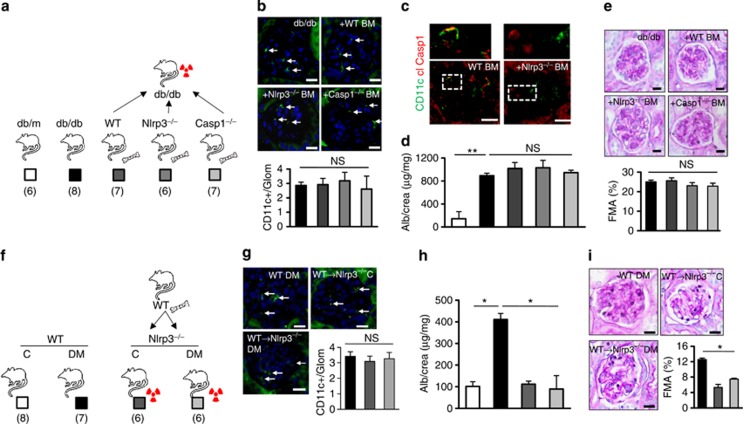Figure 7.
Non-myeloid-derived cells are sufficient to promote diabetic nephropathy. Following transplantation of Nlrp3−/− or Casp1−/− bone marrow into db/db mice (a: experimental approach) the frequency of CD11c+ cells in glomeruli is similar to that in control db/db mice (b), immunofluorescence, CD11c: green; 4,6-diamidino-2-phenylindole (DAPI) counterstain, but no cleaved caspase-1 (cl Casp1) can be detected in CD11c+ cells (c), representative immunofluorescence following transplantation of Nlrp3−/− bone marrow; cleaved caspase-1: red; CD11c: green; colocalization: yellow; white dotted lines indicate areas shown at higher magnification above. Albuminuria and FMA remain high in db/db mice despite transplantation with Nlrp3−/− or caspase-1−/− bone marrow (d, e). Conversely, diabetic and uninephrectomized Nlrp3−/− mice are protected from nephropathy despite transplantation of Nlrp3+/+ bone marrow (f: experimental approach). The frequency of CD11c+ cells in glomeruli is similar in experimental groups (g); CD11c: green; DAPI counterstain, but albuminuria and FMA remain normal in diabetic Nlrp3−/− mice despite reconstitution with Nlrp3+/+ bone marrow (h, i). Mean value±s.e.m. Number of mice (a–e and f–i) in each group is shown in parentheses in a and f; representative periodic acid–Schiff–stained glomeruli in e and i; scale bar=20 μm (b, c, e, g, and i); white arrows in b and g indicate CD11c+ cells; *P<0.05; **P<0.01. BM, bone marrow; DM, diabetic mice; FMA, fractional mesangial area; IL, interleukin; Nlrp3, nucleotide-binding domain and leucine-rich repeat pyrin 3 domain; NS, not significant; WT, wild type.

